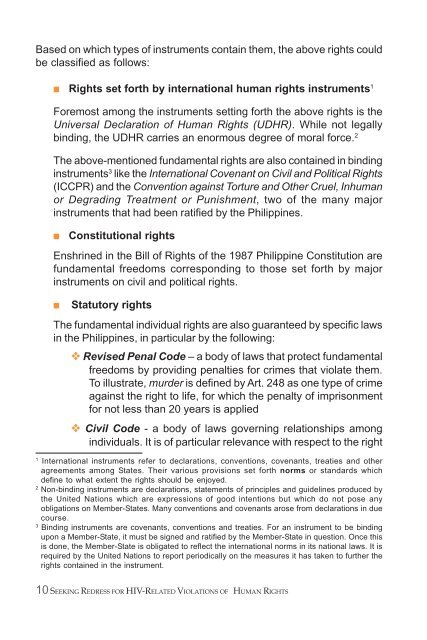Download this publication - AIDS Data Hub
Download this publication - AIDS Data Hub
Download this publication - AIDS Data Hub
- No tags were found...
Create successful ePaper yourself
Turn your PDF publications into a flip-book with our unique Google optimized e-Paper software.
Based on which types of instruments contain them, the above rights couldbe classified as follows:■ Rights set forth by international human rights instruments 1Foremost among the instruments setting forth the above rights is theUniversal Declaration of Human Rights (UDHR). While not legallybinding, the UDHR carries an enormous degree of moral force. 2The above-mentioned fundamental rights are also contained in bindinginstruments 3 like the International Covenant on Civil and Political Rights(ICCPR) and the Convention against Torture and Other Cruel, Inhumanor Degrading Treatment or Punishment, two of the many majorinstruments that had been ratified by the Philippines.■Constitutional rightsEnshrined in the Bill of Rights of the 1987 Philippine Constitution arefundamental freedoms corresponding to those set forth by majorinstruments on civil and political rights.■Statutory rightsThe fundamental individual rights are also guaranteed by specific lawsin the Philippines, in particular by the following:❖ Revised Penal Code – a body of laws that protect fundamentalfreedoms by providing penalties for crimes that violate them.To illustrate, murder is defined by Art. 248 as one type of crimeagainst the right to life, for which the penalty of imprisonmentfor not less than 20 years is applied❖ Civil Code - a body of laws governing relationships amongindividuals. It is of particular relevance with respect to the right1International instruments refer to declarations, conventions, covenants, treaties and otheragreements among States. Their various provisions set forth norms or standards whichdefine to what extent the rights should be enjoyed.2Non-binding instruments are declarations, statements of principles and guidelines produced bythe United Nations which are expressions of good intentions but which do not pose anyobligations on Member-States. Many conventions and covenants arose from declarations in duecourse.3Binding instruments are covenants, conventions and treaties. For an instrument to be bindingupon a Member-State, it must be signed and ratified by the Member-State in question. Once <strong>this</strong>is done, the Member-State is obligated to reflect the international norms in its national laws. It isrequired by the United Nations to report periodically on the measures it has taken to further therights contained in the instrument.10 SEEKING REDRESS FOR HIV-RELATED VIOLATIONS OF HUMAN RIGHTS















